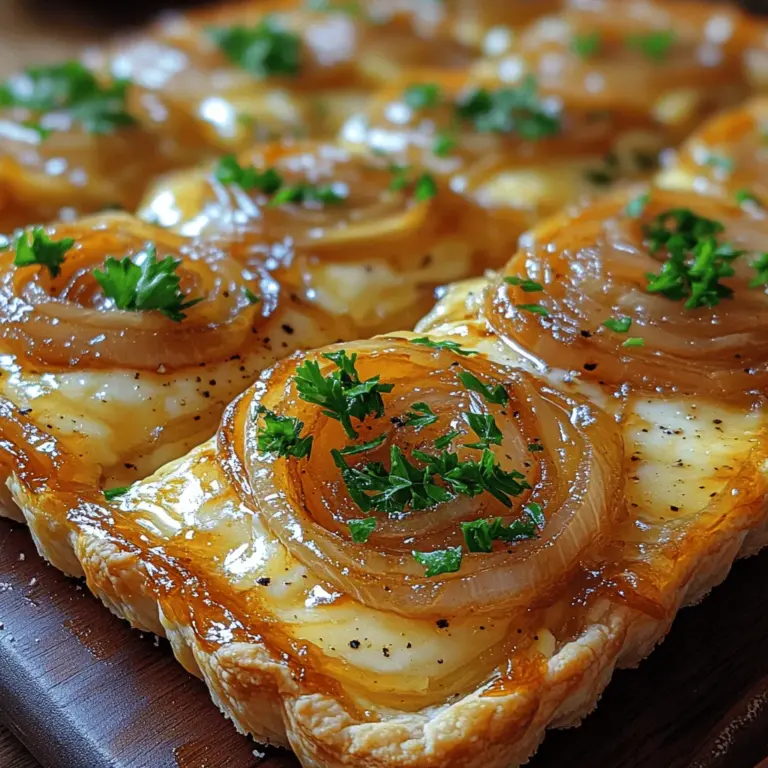Introduction
Risotto is a cherished staple of Italian cuisine, renowned for its creamy texture and rich flavors. This dish embodies the essence of comfort food, offering warmth and satisfaction with every spoonful. Among the myriad variations of risotto, mushroom risotto stands out for its earthy aroma and versatility, making it a perfect choice for any occasion, whether it’s a cozy family dinner or a sophisticated gathering.
The appeal of homemade meals lies not just in the flavors but also in the process of cooking from scratch. There’s something profoundly satisfying about standing over a pot, stirring and nurturing your ingredients as they transform into a comforting dish. Mushroom risotto, with its simple yet elegant ingredients, allows you to create a dish that is both rich and comforting, with a depth of flavor that will impress family and friends alike.
Understanding Risotto
At its core, risotto is a creamy Italian rice dish that is characterized by its unique cooking method. Unlike regular rice, which is typically boiled, risotto is prepared through a process known as “stirring.” This method allows the rice to release its starches, creating a creamy consistency that is the hallmark of a well-made risotto.
The foundation of any good risotto lies in the type of rice used. Arborio rice is the most common variety used in risotto recipes. This short-grain rice is essential for achieving the perfect texture because it has a high starch content that helps thicken the dish while remaining al dente. The starch released during cooking creates that sought-after creaminess, ensuring each bite melts in your mouth.
The traditional cooking method involves gradually adding warm broth to the rice, stirring constantly to allow the grains to absorb the liquid slowly. This technique enhances the flavors as the rice releases its starches and creates a beautifully cohesive dish. The slow cooking process also allows for the development of rich flavors, making every spoonful a delightful experience.
Key Ingredients for Mushroom Risotto
To create a truly exceptional mushroom risotto, it’s essential to choose high-quality ingredients. Here’s a detailed breakdown of the key components that will elevate your dish:
Arborio Rice
As previously mentioned, Arborio rice is the star of the show when it comes to risotto. Its short, plump grains are ideal for absorbing liquid while maintaining a firm bite. Ensure you select good-quality Arborio rice to achieve that perfect creamy texture.
Fresh Mushrooms
The choice of mushrooms can significantly impact the overall flavor of your risotto. Varieties like cremini, shiitake, or porcini are excellent options, each bringing its unique essence to the dish. Cremini mushrooms offer a mild, slightly nutty flavor, while shiitake mushrooms provide a more robust taste with a hint of umami. Porcini mushrooms, known for their intense flavor, can be used fresh or dried, with the latter adding an even deeper richness to the dish.
Broth
Using a high-quality broth is crucial for enhancing the flavor of your risotto. Whether you prefer vegetable or chicken broth, ensure it is well-seasoned and kept warm throughout the cooking process. The warmth of the broth helps the rice cook evenly and absorb flavors more effectively.
Aromatics
Onions and garlic play a pivotal role in flavoring your risotto. Start with finely chopped onions, as they provide a sweet base that complements the earthiness of the mushrooms. Adding minced garlic towards the end of sautéing the onions adds a fragrant depth to the dish.
Cheese
A generous amount of cheese is key to achieving a creamy risotto. Parmesan or Pecorino Romano are both excellent choices, lending a salty, nutty flavor while enhancing the overall creaminess. Grate the cheese finely so it melts seamlessly into the risotto.
Butter and Olive Oil
Both butter and olive oil are essential fats that contribute richness and depth to your risotto. Olive oil is used for sautéing the aromatics and mushrooms, while butter is added at the end for a luxurious finish that enhances the creamy texture.
Optional Ingredients for Customization
Risotto is a versatile dish that can be easily customized with additional ingredients. Feel free to experiment with fresh herbs like thyme or parsley, which add brightness and freshness. A splash of white wine not only enhances flavor but also adds acidity to balance the richness of the dish.
Consider adding additional vegetables or proteins, such as peas, asparagus, or cooked chicken, to create a heartier meal. These extras can elevate your mushroom risotto and make it a complete dish.
Preparation Steps for Mushroom Risotto
Now that you are familiar with the key ingredients, let’s delve into the preparation steps that will guide you to a perfect mushroom risotto:
Preparing the Broth
Start by preparing your broth. Pour your chosen broth into a saucepan and heat it over medium heat until it reaches a gentle simmer. Keeping the broth warm throughout the cooking process is essential, as adding cold broth will interrupt the cooking temperature and negatively impact the texture of the risotto.
Sautéing the Aromatics
In a large, heavy-bottomed pot, heat a combination of olive oil and a knob of butter over medium heat. Once the butter has melted, add the finely chopped onions. Sauté the onions for about 3-5 minutes until they become translucent and fragrant.
Next, add minced garlic, stirring for an additional minute until it becomes fragrant but not browned. This step is crucial, as burnt garlic can impart a bitter taste to your risotto.
Cooking the Mushrooms
Now it’s time to add your fresh mushrooms to the pot. Depending on the type of mushrooms you’ve chosen, you may need to slice or chop them into bite-sized pieces. Sauté the mushrooms in the pot for about 5-7 minutes, allowing them to release their moisture and develop a rich flavor. Stir occasionally to ensure they cook evenly and don’t stick to the bottom of the pot.
Once the mushrooms are tender and golden brown, it’s time to move on to the next step in crafting your delicious mushroom risotto.
These initial steps set the foundation for a comforting and satisfying dish that will warm your soul and impress your guests. By carefully selecting ingredients and following the traditional risotto preparation method, you’re on your way to creating a truly memorable culinary experience.
Toasting the Rice: The Importance of This Step in Flavor Development
Toasting the rice is a critical step in the risotto-making process. It enhances the nutty flavor of the rice, adding depth to your dish. Begin by heating a tablespoon of olive oil or butter in your sauté pan over medium heat. Once the fat is shimmering, add your Arborio rice and stir continuously for about 2-3 minutes. You’ll notice a slight change in color, and the rice will begin to emit a toasted aroma. This step not only enriches the flavor profile of your risotto but also helps in achieving that creamy texture we all desire.
Gradually Adding Broth: The Method of Cooking and Stirring for Creamy Risotto
The key to making perfect risotto lies in the gradual addition of broth. After toasting your rice, it’s time to add the warm chicken or vegetable broth, one ladle at a time. Ensure your broth is simmering gently in another pot so that the temperature is maintained. Pour the first ladle of broth into the rice and stir gently. This stirring is vital; it helps release the starches from the rice, which are responsible for the creamy consistency of the risotto.
Allow the rice to absorb the broth completely before adding the next ladle. This method not only prevents the rice from becoming mushy but also encourages even cooking. Continue this process, stirring frequently, until the rice is al dente and has a creamy texture. Depending on the quantity of rice used, this could take around 20-25 minutes.
Incorporating Cheese and Butter: Timing for the Best Results
Once your risotto reaches the perfect creamy consistency, it’s time to elevate its flavor with cheese and butter. Remove the pan from the heat before adding in your grated Gruyère cheese and a knob of unsalted butter. This timing is crucial; removing the pan from the heat prevents the cheese from becoming stringy and allows it to melt smoothly into the risotto. Stir vigorously until the cheese and butter are fully incorporated, enhancing the rich, creamy texture.
For an added layer of flavor, consider mixing in a tablespoon of freshly grated Parmesan cheese alongside the Gruyère. This combination will create a beautifully savory risotto that delights the palate.
Final Touches: Adjusting Seasoning and Adding Herbs
Before serving, take a moment to taste your risotto. Season with salt and freshly cracked black pepper to taste. A squeeze of fresh lemon juice can also brighten the dish, balancing the richness of the cheese and butter.
Fresh herbs are the perfect finishing touch. Chopped parsley or chives not only add color but also a fresh flavor that complements the creamy risotto. Stir them in just before serving to retain their vibrant color and taste.
Serving Suggestions for Mushroom Risotto
Plating Techniques for a Visually Appealing Dish
Presentation is key when serving your mushroom risotto. Begin by using a large spoon to create a mound of risotto in the center of a warm plate. Use the back of the spoon to gently shape the risotto, giving it a slight indentation in the middle for added elegance.
For a restaurant-quality touch, consider drizzling a little extra virgin olive oil around the risotto or placing a few sautéed mushrooms artfully on top. This not only enhances the visual appeal but also gives your guests a hint of what’s inside.
Suggested Accompaniments: Salad, Wine Pairings, or Crusty Bread
Mushroom risotto pairs wonderfully with a fresh, crisp salad. A simple arugula and lemon vinaigrette salad can provide a refreshing contrast to the creaminess of the risotto.
In terms of wine, a glass of white wine such as Chardonnay or a light-bodied red like Pinot Noir complements the earthy flavors of the mushrooms beautifully.
Lastly, consider serving your risotto with a side of crusty bread. A rustic baguette or sourdough loaf can be delightful for soaking up any leftover risotto, making for a truly satisfying meal.
Garnishing Ideas: Fresh Herbs, Additional Mushrooms, or Drizzles of Olive Oil
Garnishing your mushroom risotto can elevate the dish from simple to spectacular. Fresh herbs like basil or thyme can add a pop of color and freshness. For a more decadent touch, scatter some sautéed wild mushrooms on top to echo the flavors within the risotto.
A drizzle of high-quality olive oil or a truffle oil can also impart a luxurious finish, enhancing the overall flavor experience.
Nutritional Benefits of Mushroom Risotto
Overview of the Nutritional Value of Key Ingredients
Mushroom risotto not only satisfies your taste buds but also packs a nutritional punch. Arborio rice is a source of carbohydrates that provides energy, while mushrooms are low in calories but high in essential nutrients.
The addition of cheese contributes protein and calcium, making this dish a well-rounded meal.
Benefits of Mushrooms: Rich in Vitamins, Minerals, and Antioxidants
Mushrooms are often overlooked for their health benefits. They are rich in B vitamins, which play a crucial role in energy metabolism. Additionally, mushrooms contain selenium, an antioxidant that helps combat oxidative stress in the body.
Certain varieties, like shiitake and maitake, may even have immune-boosting properties, making your risotto not only delicious but beneficial for your health.
Balancing the Meal: How to Make It a Well-Rounded Dish with Protein and Fiber
To create a balanced meal, consider adding protein and fiber to your risotto. You could incorporate cooked chicken, shrimp, or even plant-based proteins like lentils or chickpeas.
Adding a side of sautéed greens or a bean salad can increase the fiber content of your meal, promoting satiety and nutritional balance.
Variations of Mushroom Risotto
Different Types of Mushrooms and Their Unique Flavors
One of the great advantages of risotto is its versatility, especially when it comes to mushrooms. While cremini and button mushrooms are classic choices, experimenting with different varieties can create exciting new flavors.
Consider using portobello mushrooms for a meaty texture, or shiitake mushrooms for their rich, umami flavor. Wild mushrooms can also add an earthy depth that elevates your dish to gourmet status.
Incorporating Seasonal Vegetables: How to Adapt the Recipe Throughout the Year
Mushroom risotto can easily be adapted with seasonal vegetables. In the spring, consider adding asparagus or peas for a fresh touch. Summer brings the opportunity to incorporate zucchini or fresh herbs, while autumn can inspire the addition of roasted butternut squash or pumpkin.
Winter vegetables like kale or Brussels sprouts can also be sautéed and stirred into the risotto for a hearty, warming dish.
Vegan and Vegetarian Adaptations: Dairy-Free Alternatives and Plant-Based Options
For those following a vegan or dairy-free diet, mushroom risotto can still be enjoyed. Substitute the cheese with nutritional yeast for a cheesy flavor, and use vegetable broth and olive oil instead of butter.
You can also add plant-based protein sources like lentils or chickpeas to enhance the nutritional value without compromising on taste.
Flavor Twists: Adding Spices or Alternative Cheeses for Diverse Tastes
Experimenting with spices can add a whole new dimension to your risotto. Adding a pinch of nutmeg can enhance the earthiness of the mushrooms, while a sprinkle of smoked paprika can impart a subtle smokiness.
For cheese lovers, consider using a mix of cheeses such as feta or goat cheese for a tangy twist. Alternatively, a dollop of pesto stirred in at the end can give a burst of fresh flavor.
Common Mistakes to Avoid When Making Risotto
Overcooking the Rice: Signs to Watch For
The key to perfect risotto is achieving an al dente texture. Overcooking can lead to mushy rice, which detracts from the overall experience. Keep an eye on the rice as it cooks, and taste it frequently. You want it to be tender but still firm to the bite.
Neglecting to Stir: The Importance of Constant Attention
Risotto requires attention. Neglecting to stir can lead to uneven cooking and can cause the rice to stick to the bottom of the pan, creating a burnt layer. Stirring not only helps release the starches but also ensures even cooking.
Using Cold Broth: How It Affects the Cooking Process
Always use warm broth when making risotto. Cold broth will cool down the rice and disrupt the cooking process, resulting in an unevenly cooked dish. Keep your broth on a low simmer while you cook the risotto to ensure a consistent temperature.
Underseasoning: The Crucial Role of Salt and Seasoning Throughout Cooking
Salt is an essential ingredient in risotto. Underseasoning can lead to a bland final dish. Season the broth adequately before adding it to the rice, and taste as you go. A pinch of salt can enhance the flavors and bring the dish to life.
Conclusion
Homemade mushroom risotto is more than just a comforting dish; it’s an opportunity to explore flavors, textures, and creativity in the kitchen. This recipe invites you to experiment with different ingredients and adapt it to your taste, whether by incorporating seasonal produce or trying out various mushroom varieties.
Sharing this classic recipe with family and friends creates lasting memories, making it not only a meal but a delightful experience. So gather your ingredients, roll up your sleeves, and indulge in the joyous process of creating your very own mushroom risotto masterpiece!


